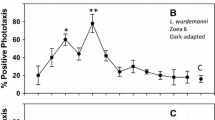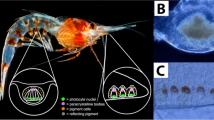Abstract.
Cilia at the posterior pole of demosponge larvae are known to cause directional swimming, sometimes in response to light gradients, but so far neither the spectral sensitivity of, nor the molecular basis for, this response has been investigated. We exploited the fact that the larval cilia respond to sudden changes in light intensity, a shadow response, in order to determine the action spectrum of photosensitivity. Our results show that larvae of the haplosclerid sponge Reniera sp. respond most to blue light (440 nm), and have a smaller, secondary response peak to orange-red light (600 nm). These data suggest that the photoreceptive pigment in sponge larvae may be a flavin or carotenoid.
Similar content being viewed by others
Author information
Authors and Affiliations
Additional information
Electronic Publication
Rights and permissions
About this article
Cite this article
Leys, S.P., Cronin, T.W., Degnan, B.M. et al. Spectral sensitivity in a sponge larva. J Comp Physiol A 188, 199–202 (2002). https://doi.org/10.1007/s00359-002-0293-y
Accepted:
Issue Date:
DOI: https://doi.org/10.1007/s00359-002-0293-y




